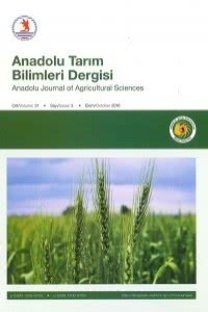Etlik piliçlerde farklı yem farklı yem formlarının performansa ve bazı karkas özelliklerine etkileri
Değişik yem formlarının (toz, granül ve peiet yem) etlik piliçlerin performansına etkilerini belirlemek için yürütülen bu araştırmada 1640 adet Ross PM3 etlik civciv kullanılmıştır. 0-3 haftalar arasında tüm deneme gruplarına toz yem, 4-6 haftaları arasında ise toz, granül ve pelet yem verilmiştir. 42. günde yapılan kesim sonucunda toz, granül, ve pelet yem alan gruplarda canlı ağırlık artışı ortalamaları sırasıyla 2234, 2275 ve 2354 g; yem tüketimi ortalamaları 3971, 3954 ve 3797 g; yemden yararlanma oranları 1.778, 1.738, 1.613; yaşama gücü %98.90, 97.25 ve 97.70; verim indeksleri 302.76, 314.62 ve 349.86; karkas randımanları %77.7, 78.7 ve 77.6 olarak tespit edilmiştir. Yem formunun yemden yararlanma oranı ve verim İndeksine etkisi önemli bulunurken (PO.05) diğer özellikler arasındaki farklılıklar önemsiz olmuştur. 5. hafta sonunda pelet yem formu hem toz hem de granül yeme göre daha fazla canlı ağırlık artışı sağlamıştır (PO.05). Toz yem formunda karkasın %'si olarak taşlık ağırlığı artarken (PO.05) kalp, karaciğer ve abdominal yağ ağırlıkları arasındaki farklılıklar önemsiz bulunmuştur (P>0.05). Maliyet analizi sonucunda pelet ve granül formunun toz forma göre daha ekonomik olduğu saptanmıştır....
Effects of different feed forms on performance and some carcass traits of broilers
The effects of different feed forms (mash, granule, pellet forms) on broiler performance were determined in this trial in which 1640 Ross PM3 type broilers were used. All of the groups were fed only mash form during 0-3 weeks period and fed mash, granule and pellet forms during 4-6 weeks period. At the end of the trial which was lasted 42 days, live weight gains, feed consumptions, feed efficiency ratios, viability ratios, production indices, dressing percentages were as follows; 2234, 2275 and 2354 g; 3971, 3954 and 3797 g; 1.778, 1.738, 1.613; 98.90, 97.25 and 97.70%; 302.76, 314.62 arid 349.86; 77.7, 78.7 and 77.6% for 3 groups, respectively. While the effect of feed forms on feed efficiency ratios and performanceindices were statistically significant (PO.Q5), there were no differences in terms of the other traits among the groups (P>0.05). At the end of the 5th week live weight gain increased in pellet form compare to mash and granule forms (P<0.05). Gizzard weight as carcass percent in mash form is higher than the other forms (P<0.05). There were no differences among the feed forms in terms of heart weight, liver weight and abdominal fat (P>0.05). It was concluded that optimum economical results obtained by feeding pellet and crumble form.
